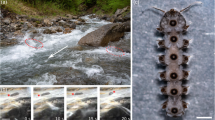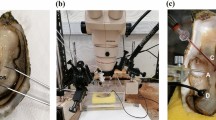Abstract
Electrophysiological activity in the branchial basket of the clonal tunicate Clavelina huntsmani was monitored while exposing study specimens to injury fluids of conspecifics. Extracellular suction electrode recordings were used. Ciliary arrest potentials, generated by simultaneous arrest of stigmatal cilia across the branchial basket, were consistently precipitated within 3 min of exposure to conspecific injury fluids. Control fluid cues, including boiled fluid from injured conspecifics, did not provoke a similar response. This suggests that a heat-labile compound—potentially an alarm pheromone—is involved. The species-specific nature of the response constitutes the first evidence produced for alarm signaling in ascidians. This may serve to advance our understanding of both predator–prey interactions in sessile, clonal marine invertebrates and the possible ecological relevance of some of the diverse bioactive metabolites produced by ascidians.




Similar content being viewed by others
References
Abbott D, Newberry A (1980) Urochordata: the tunicates. In: Morris R, Abbott D, Haderlie E (eds) Intertidal invertebrates of California. Stanford University Press, Stanford, Calif., USA, pp 177–226
Al Abassi S, Birkett M, Pettersson J, Pickett J, Wadhams L, Woodcock C (2000) Response of the seven-spot ladybird to an aphid alarm pheromone and an alarm pheromone inhibitor is mediated by paired olfactory cells. J Chem Ecol 26:1765–1771
Amsler C, McClintock J, Baker B (2001) Secondary metabolites as mediators of trophic interactions among Antarctic marine organisms. Am Zool 41:17–26
Arkett S, Mackie G, Singla C (1989) Neuronal organization of the ascidian (Urochordata) branchial basket revealed by cholinesterase activity. Cell Tissue Res 257:285–294
Bone Q, Mackie G (1982) Urochordata. In: Shelton G (ed) Electrical conduction and behaviour in ‘simple’ invertebrates. Clarendon, Oxford, pp 473–535
Chivers D, Smith R (1998) Chemical alarm signaling in aquatic predator–prey systems: a review and prospectus. Ecoscience 5:338–352
Davis W (1985) Neural mechanisms of behavioral plasticity in an invertebrate model system. In: Selverston A (ed) Model neural networks and behavior. Plenum, New York, pp 263–282
Faulkner D (2000) Marine natural products. Nat Prod Rep 18:1–48
Fenical W (1986) Marine alkaloids and related compounds. In: Pelletier SW (ed) Alkaloids: chemical and biological perspectives, vol 4. Wiley, New York, USA, pp 275–330
Hardege J (1999) Nereidid polychaetes as model organisms for marine chemical ecology. Hydrobiologia 402:145–161
Ireland C, Roll D, Molinski T, McKee T, Zabriskie T, Swersey J (1988) Uniqueness of the marine chemical environment: categories of marine natural products from invertebrates. In: Fautin DG (ed) Biomedical importance of marine organisms. Mem Calif Acad Mar Sci 13:41–57
Jacobsen H, Stabell O (1999) Predator-induced alarm responses in the common periwinkle, Littorina littorea: dependence on season, light conditions, and chemical labelling of predators. Mar Biol 134:551–557
Lindquist N, Hay M, Fenical W (1992) Defense of ascidians and their conspicuous larvae—adult vs larval chemical defenses. Ecol Monogr 62:547–568
Mackie G (1974) Behaviour of a compound ascidian. Can J Zool 52:23–27
Mackie G, Singla C (1983) Coordination of compound ascidians by epithelial conduction in the colonial blood vessels. Biol Bull (Woods Hole) 165:209–220
Mackie G, Singla C (1987) Impulse propagation and contraction in the tunic of a compound ascidian. Biol Bull (Woods Hole) 173:188–204
Mackie G, Paul D, Singla C, Sleigh M, Williams D (1974) Branchial innervation and ciliary control in the ascidian Corella. Proc R Soc Lond B Biol Sci 187:1–35
Palumbi S, Jackson J (1982) Ecology of cryptic coral communities. II. Recovery from small disturbance events by encrusting Bryozoa: the influence of “host species” and lesion size. J Exp Mar Biol Ecol 64:103–115
Petersen J, Mayer S, Knudsen M (1999) Beat frequency of cilia in the branchial basket of the ascidian Ciona intestinalis in relation to temperature and algal cell concentration. Mar Biol 133:185–192
Riga E, Perry R, Johnston M (1997) Electrophysiological responses of male potato cyst nematodes, Globodera rostochiensis and G. pallida, to some chemicals. J Chem Ecol 23:417–428
Rittschof D, Tsai D, Massey P, Blanco L, Kueber G, Haas R (1992) Chemical mediation of behaviour in hermit crabs: alarm and aggregation cures. J Chem Ecol 18:959–984
Rosenberg R, Selander E (2000) Alarm signal response in the brittle star Amphiura filiformis. Mar Biol 136:43–48
Smith R (1992) Alarm signals in fishes. Rev Fish Biol Fish 2:33–63
Stoeker D (1980) Chemical defenses of ascidians against predators. Ecology 61:1327–1334
Takahashi K, Baba S, Murakami A (1973) The “excitable” cilia of the tunicate, Ciona intestinalis. J Fac Sci Tokyo Univ Sect IV Zool 13:123–137
Tarjuelo I, Lopez S, Codina M, Turon X (2002) Defense mechanisms of adults and larvae of colonial ascidians: patterns of palatability and toxicity. Mar Ecol Prog Ser 235:103–115
Teo S, Ryland J (1994) Toxicity and palatability of some British asicidians. Mar Biol 120:297–303
Toth G, Pavia H (2000) Water-borne cues induce chemical defense in a marine alga (Ascophyllum nodousm). Proc Natl Acad Sci USA 97:14418–14420
Author information
Authors and Affiliations
Corresponding author
Additional information
Communicated by R.J. Thompson, St. John’s
Rights and permissions
About this article
Cite this article
Pelletier, N. Conspecific injury fluids induce an electrophysiological response in the clonal tunicate Clavelina huntsmani. Marine Biology 145, 1159–1165 (2004). https://doi.org/10.1007/s00227-004-1401-z
Received:
Accepted:
Published:
Issue Date:
DOI: https://doi.org/10.1007/s00227-004-1401-z




